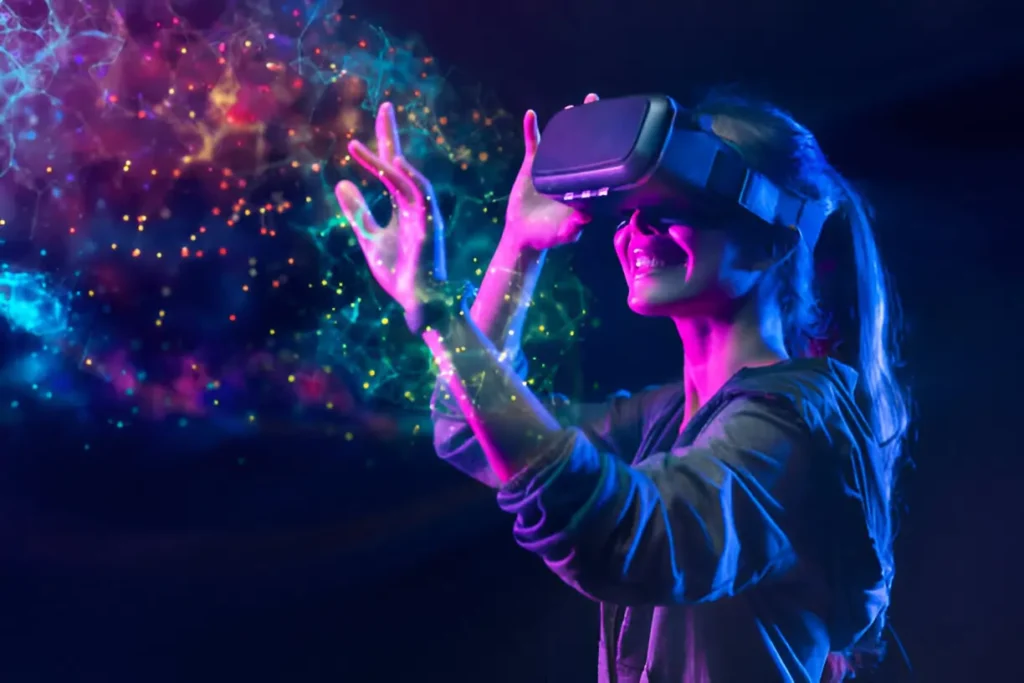Virtual reality (VR) has grown from a niche technology into a powerful tool for entertainment and engagement. Celebrities, always at the forefront of innovation, are embracing VR not just for gaming or media appearances but to build deeper, more meaningful connections with their fans. From exclusive concerts to immersive storytelling, VR is reshaping how stars interact with their audiences.
Virtual Concerts and Live Performances
One of the most prominent ways celebrities are using VR is by hosting virtual concerts. Traditional concerts, while thrilling, often come with barriers such as travel, cost, and venue size. Virtual reality removes those obstacles, offering fans across the globe front-row experiences from the comfort of their homes.
Artists like Travis Scott and Ariana Grande have pioneered this approach. Travis Scott’s virtual concert inside the popular video game Fortnite attracted millions of viewers, delivering an audio-visual spectacle that blended music with surreal landscapes. Ariana Grande followed with her Rift Tour, creating an interactive experience where fans could dance, float, and fly alongside her avatar.
These virtual events aren’t just concerts; they are full experiences. Fans can interact with one another, customize their appearances, and sometimes even influence the course of the show. VR technology makes it possible to blur the lines between performer and audience, creating a shared experience that feels far more personal than watching from the back row of a stadium.
VR Meet-And-Greets and Fan Experiences
Beyond performances, celebrities are exploring VR for more intimate interactions, like meet-and-greets and exclusive fan experiences. Traditionally, meeting a celebrity involved winning a contest or buying a pricey VIP ticket. Now, VR brings these encounters into fans’ homes.
Platforms like Oculus Venues and Horizon Worlds have opened up new avenues for stars to host virtual meetups. Fans can attend live interviews, participate in Q&A sessions, or even explore custom-designed virtual spaces that reflect a celebrity’s personality or latest project.
In some cases, celebrities are creating entirely original VR worlds. For instance, artists launch virtual art galleries where fans can “walk” through exhibits, musicians build fantasy lands tied to their albums, and actors offer behind-the-scenes tours of movie sets recreated in VR.
At these VR events, fans sometimes find additional entertainment elements like trivia games, scavenger hunts, and even simulations of a coin flip betting game where they can win exclusive merchandise. These activities heighten the sense of interactivity, making fans feel not just like spectators but participants in the celebrity’s universe.
Storytelling and Immersive Narratives
Celebrities are also venturing into VR storytelling, offering fans a chance to experience narratives in ways never possible before. Immersive VR films and experiences enable users to step directly into the stories celebrities want to tell.
For example, actor Jon Hamm starred in “Dispatch,” a VR thriller where viewers are placed in the middle of a suspenseful police dispatch call. Rather than passively watching the story unfold, fans experience it from a first-person perspective, amplifying emotional engagement.
Similarly, Reese Witherspoon has backed several VR projects through her production company, aiming to highlight underrepresented voices through immersive storytelling. These experiences allow fans to “live” a day in someone else’s shoes, often leaving a lasting impact.
For celebrities, VR storytelling isn’t just about expanding creative horizons. It’s a way to build deeper bonds with audiences, who appreciate the thought and effort put into delivering something beyond traditional media formats.
Virtual Reality in Sports and Athlete Engagement
Athletes, too, are embracing VR to connect with their fan bases. Professional sports stars use VR to offer fans unique perspectives, like stepping onto the pitch during a decisive soccer match or taking a shot from the free-throw line in a championship game.
Famous athletes like Cristiano Ronaldo and LeBron James have invested in VR companies or created virtual experiences that simulate their training sessions, allowing fans to “train” alongside them. These VR engagements provide a behind-the-scenes look at an athlete’s preparation, discipline, and daily life—a glimpse that would otherwise be impossible to capture.
Teams are also leveraging VR for fan engagement. Major League Baseball, for instance, offers VR experiences where fans can watch games from the dugout or behind home plate, giving them an insider’s view usually reserved for players and coaches.
This democratization of access brings fans closer to their favorite athletes and teams, making loyalty stronger and creating memories that last beyond a single season.
The Future of Celebrity-Fan Connections Through VR
Looking ahead, VR is poised to play an even bigger role in celebrity culture. Advances in technology, such as haptic feedback suits and full-body motion tracking, could make virtual encounters even more lifelike. Fans might one day “hug” their favorite singer, “high-five” a beloved athlete, or “collaborate” creatively with an artist inside virtual studios.
There’s also potential for personalization at a massive scale. AI-driven avatars could allow celebrities to “meet” thousands of fans individually, providing unique interactions while the star is actually offline. Virtual fan clubs may spring up, offering members-only VR experiences like early album listening sessions, film previews, or customized messages from celebrities.
However, as VR engagement grows, it will also require thoughtful moderation. Preserving the sense of authenticity while navigating issues like accessibility and privacy will be critical. Fans want meaningful experiences, not mass-produced simulations that feel commercial or disconnected.
Ultimately, VR is giving celebrities unprecedented ways to deepen their relationships with audiences, and fans are responding with enthusiasm and loyalty.
Conclusion
Virtual reality is redefining the ways celebrities interact with their fans. From massive virtual concerts and intimate VR meet-and-greets to immersive storytelling and sports experiences, VR enables fans to connect with their favorite stars on a much deeper, more personal level. As technology continues to evolve, the possibilities for fan engagement will only grow, offering more authentic, memorable experiences that bridge the gap between celebrities and the people who admire them. The age of distant celebrity worship is fading, making room for a future where connection and creativity are just a headset away.
Read more: K8CC – Explore the Official Trang chủ K8cc for Premium Online Betting
